Vatican Art Story | Location | Opening Hours Tickets | Authorisations
Art Story Sistine Chapel | Raphael | Caravaggio | da Vinci | Giotto | Titian | Veronese | Sculptures | Van Gogh |
The Sistine Chapel and Michelangelo's Frescoes at the Vatican in Rome

Michelangelo Sistine Chapel ceiling The Sistine Chapel owes its name to Pope Sixtus IV, who built it between 1477 and 1483. It is in this chapel that the election of the Pope takes place.
It is 40 metres long by 13 metres wide and its height is 21 metres.
Originally, the vault of the Sistine Chapel represented a starry blue sky as still found in many churches.
In May 1506 Pope Julius II asked Michelangelo to paint the ceiling of the Sistine Chapel: a gigantic surface covered with frescoes remained unchanged until today.
The Frescoes of the Sistine Chapel: a technical feat
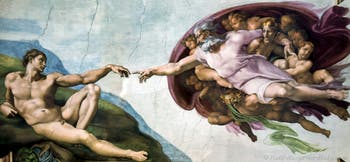
Michelangelo Sistine, Creation of Adam These frescoes represent a colossal work in its preparation and realization.
Two years later, in 1508, Michelangelo began painting once the scaffolding and the necessary pigments were ready for use, and after finding and hiring competent collaborators and assistants.
All without forgetting the preparation of the preparatory drawings that Michelangelo had obviously had to present to Julius II to allow him to begin the realization of the frescoes.
The scaffolding itself, invented by the brilliant Michelangelo, touched neither the arch nor the ground and its height could be adjusted according to the curvature of the arch to limit the painfulness of the work.
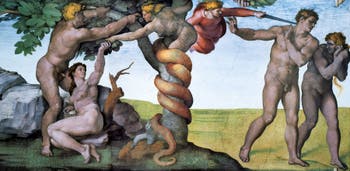
Michelangelo Sistine Adam and Eve Painting more than twenty metres high required in addition to hoist up there all the necessary products: lime, pigments, water, etc.
Not to mention the climatic conditions that required heating the chapel with braziers in winter, then to be able to withstand the heat of summer with the sun just above the vault.
No electric lighting at the time, Michelangelo had to settle for candlelight because the scaffolds hindered the passage of light from the windows and prevented them from properly illuminating the vault.
Finally, one must imagine the poor Michelangelo, forced to paint with his head turned back and his arm in the air during the four years that his work lasted.
The Sistine Chapel was inaugurated on October 31, 1512.
Glasses and Vaults of the Sistine Chapel
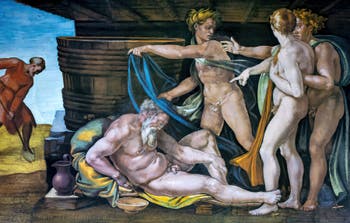
Michelangelo, Noah's drunkenness Glasses and vaults are located under the vault that they connect with the windows.
Michelangelo represented the figures of the ancestors of Christ, those who were waiting for his coming, from Abraham to Joseph.
Their names are written on a central panel in each of the vaults and glasses.
The representations of the vault of the Sistine Chapel
Although there is no trace of it, it is assumed that Michelangelo would have called upon theologians of the Pontifical Court to define the theme of the vault and the different characters of the composition.
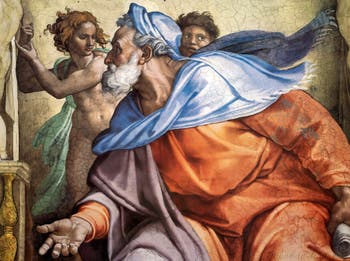
Michelangelo Sistine, Ezekiel On the side of the main entrance and altar, we see the Prophets Zechariah and Jonah at every end of the vault.
Let us remember that Zechariah prophesied Jesus's entry into Jerusalem and Jonah foreshadows the Risen Christ.
The frescoes of the vault itself represent the nine scenes of Genesis, in the order of their positioning:
Noah's drunkenness,
The Universal Flood,
Noah's Sacrifice,
Original Sin,
The Creation of Eve,
The Creation of Adam,
God separates the Earth from the Waters,
The Creation of the Sun, Moon and Plants
God separates Light from Darkness.
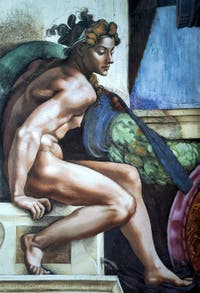
Michelangelo, Ignudo Three scenes are devoted to the creation of the world, three to the story of Noah and three to that of Adam.
All these biblical episodes are represented as visions located just above the faithful who are in the chapel.
The four corners are represented: Judith and Holofernes, David and Goliath, the Bronze Snake and the Punishment of Aman.
The Hebrews Prophets and the Greco-Roman Sibyls of the Sistine Chapel
These episodes are framed by the Prophets and the Sibyls, each accompanied by two cherubim without wings.Recall that in the Old Testament the Prophets were chosen by God to address men, while in the so-called pagan world, the sibyls were those who had the gift of prophecy.
It is on the sibyls and the Prophets that Christian culture rests, they proclaim the light of Revelation.
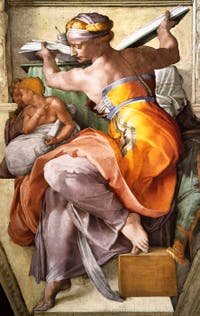
Michelangelo Libyan Sibyl Michelangelo placed them face to face on either side of the vault, with a Sibyl facing a Prophet.
The Delphic Sibyl faces Joel, Isaiah faces the Erythraean Sibyl, Ezekiel is in front of the Cumaean Sibyl, Daniel faces the Persian Sibyl and Jeremiah to the Libyan Sibyl.
They are perched on marble cubes in poses quite offbeat compared to the other characters represented by Michelangelo.
In addition to their total nudity, their attitudes are narcissistic, exhilarating, dreaming or even frightened enough to give rise to many interpretations.
Many have seen angels there, but this is not everyone's opinion.
Concerning the Ignudi who support garlands of oak leaves and acorns, some critics considered that it should be seen as a comparison with their genitals.
It should also be noted that Michelangelo's Ignudi seem to be the same age as the three sons of Noah who took part in the sacrifice.
Indeed, it is now considered that the Ignudi are the servants of the universal Christian sacrifice, the golden acorns and medallions would in fact be symbols of the Passion and of the Church and thus proclaim the Eucharist.
Art Story Sistine Chapel | Raphael | Caravaggio | da Vinci | Giotto | Titian | Veronese | Sculptures | Van Gogh |
Vatican Art Story | Location | Opening Hours Tickets | Authorisations
Back to Top of Page

